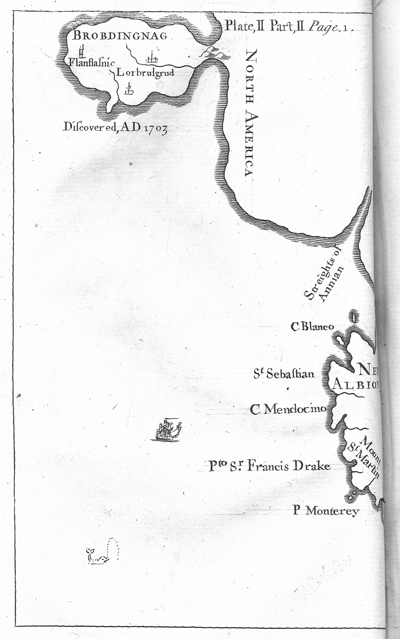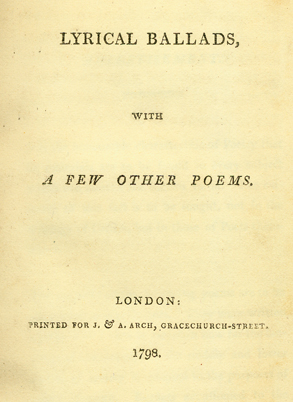Literary Classics
Exploration truth was often stranger than fiction. In the Age of Exploration, explorers were the great storytellers. And their act was a hard one for fiction to follow. William Dampier’s A New Voyage Round the World, published in 1697, ran through three printings in its first nine months. Encouraged by its success, the buccaneer-explorer immediately began a sequel, Voyages and Descriptions, which appeared in 1699 to great acclaim, from the public, fellow mariners, and Royal Society fellows alike. Almost single-handedly, he had created a receptive market for a new genre, travel writing. Thus, by the early 1700s, audiences awaited the publication of the next expedition’s adventures with great anticipation. (By the time of Captain James Cook, multivolume publications about Pacific voyages were selling out within days.) If it is difficult sometimes to tell travel writing and fiction apart, it is because they share the same elements of character, setting, and drama, driven by narrative. It is not surprising then, that whenever English literary scholars debate about which was the first English novel, Daniel Defoe’s Robinson Crusoe is often mentioned as a credible candidate. Defoe was an admirer of Dampier and recognized that good fiction must appeal to the reader’s five senses.
Frontispiece to Defoe's The Life and Strange Surprizing Adventures of Robinson Crusoe, of York, Mariner: Who Lived Eight and Twenty Years, All Alone in an Un-inhabited Island on the Coast of America, near the Mouth of the Great River Oroonoque; Having Been Cast on Shore by Shipwreck, Wherein All the Men Perished but Himself. With an Account How He Was at Last as Strangely Deliver’d by Pyrates. 1st ed. London, 1719. [Rare Books Division]
Alexander Selkirk (a possible model for Robinson Crusoe)
The castaway travails of the Scottish sailor Alexander Selkirk (1676–1721) are one of the likely sources of Defoe’s inspiration for Robinson Crusoe. In 1703, he joined buccaneer-explorer William Dampier’s expedition to the Pacific, which went hunting for Spanish treasure ships along the west coast of South America. Dampier was captain of the St. George, and Thomas Stradling commanded the Cinque Ports; Selkirk was quartermaster on the Cinque Ports. In the fall of 1704, the ships parted ways because of a dispute between the captains; seriously damaged, the Cinque Ports made its way to the Juan Fernández Islands for repair. Doubting the ship’s seaworthiness, Selkirk demanded to be left ashore. His wish was granted, but he quickly regretted his decision and ran along the beach, begging to be taken back, as the ship sailed away. All he had was a musket, some gunpowder, carpenter’s tools, a knife, a Bible, and some clothing. For more than four years he endured a lonely existence on the remote island, adapting but eventually thriving. (The Cinque Ports later foundered and most of its crew was lost.) Ironically, Selkirk was rescued in 1709 by English ships that, once again in pursuit of Spanish gold, were piloted by Dampier. (For more about Dampier, see the Explorers’ section.)
This is the first printed account of Selkirk’s rescue on Isla Más a Tierra (also called Aguas Buenas) in the Juan Fernández archipelago of Chile. (In 1966, the island was officially renamed Robinson Crusoe.)
[February 2, 1709] Immediately our pinnace return’d from the shore, and brought abundance of Craw-fish, with a Man cloth’d in Goat-skins, who look’d wilder than the first Owners of them. He had been on the Island four Years and four Months, being left there by Capt. Stradling in the Cinque-Ports; his Name was Alexander Selkirk a Scotch Man, who had been Master of the Cinque-Ports, a Ship that came here last with Capt. Dampier, who told me this was the best Man in her; so I immediately agreed with him to be a Mate on board our Ship. ’Twas he that made the Fire last night when he saw our Ships, which he judg’d to be English. . . . At his first coming on board us, he had so much forgot his Language for want of Use, that we could scarce understand him, for he seem’d to speak his words by halves. [pp. 124–25, 129]
One can only imagine the overwhelming joy and gratitude of Selkirk when he was rescued. He had reason to be speechless.
“Alexander Selkirk Makes His Cats and Kids Dance before Captn. Cook[e] and His Company.” From vol. 2 of David Henry’s An Historical Account of All the Voyages Round the World, Performed by English Navigators . . . (London, 1774) [Cotsen Collection].
A fanciful illustration? Though Selkirk had tamed island cats and goats, and told tales of dancing and singing with his pets in the moonlight, Rogers’s account contains no description of such a performance taking place when Selkirk was found. “Cook” is Edmund Cooke, one of the officers on the Woodes Rogers/William Dampier ships that rescued Selkirk.
Bellin, Jacques Nicolas, 1703–1772. “Carte particuliere de l’Isle de Juan Fernandés. . . .” Copperplate map, with hand color, 14 × 28 cm. Probably issued in abbé Prévost’s Histoire générale des voyages . . . (Paris, 1753) [Historic Maps Collection].
This is Isla Más a Tierra (known today as Robinson Crusoe), the largest of the three islands that constitute the Juan Fernández group. When explorers’ narratives mention stops at Juan Fernández, they usually are referring to this island.
Lemuel Gulliver [frontispiece, vol. 1]
Sir Isaac Newton (1642–1727), the celebrated English mathematician, was president of the Royal Society at the time of this publication. Recent scholars argue that Swift’s portrait of Gulliver bears a striking resemblance to that of Newton, which had been painted the year before by the English artist John Vanderbank (1694–1739). Given that Swift satirizes the Society in part 3, the connection is not unfounded.
Part 1, “A Voyage to Lilliput,” reads like an explorer’s narrative:
It would not be proper, for some Reasons, to trouble the Reader with the Particulars of our Adventures in those Seas: Let it suffice to inform him, that in our Passage from thence to the East-Indies, we were driven by a violent Storm to the Northwest of Van Diemen’s Land. By an Observation, we found ourselves in the Latitude of 30 Degrees 2 Minutes South. Twelve of our Crew were dead by immoderate Labour, and ill Food, the rest were in a very weak Condition. [vol. 1, p. 5]
The audience is already willing to follow the narrator on his adventure into new and strange lands on the other side of the globe.
Lilliput and Blefuscu [plate 1 in vol. 1, part 1]
These two fictional island nations of little people are shown on the map to be located to the west of a line running between Sumatra and Van Dieman’s Land (today’s Tasmania) in the southeast part of the Indian Ocean. Swift places them within latitudes where explorers had been seeking the great Southern Continent—and west of where Abel Tasman (1603?–1659) and William Dampier (1651–1715) explored along the coast of western Australia in the preceding century. In other words, Swift’s geography makes them believable. (For more about Tasman and Dampier, see the Explorers section.)
Brobdingnab [plate 2 in vol. 1, part 2]
Likewise with Brobdingnab: Swift has positioned his land of giants in an area of the North Pacific that had yet to be thoroughly explored by Europeans. Sir Francis Drake’s “New Albion” appears far to the south. The “Streights of Annian” refer to the conjectured Strait of Anian, or Northwest Passage, which had been the subject of exploration on the eastern side of North America for centuries, but only recently on the western side by Drake in the 1570s. (For more about Drake, see the Explorers section.) Hence, Swift’s country is near enough to real territory to be credible but far enough away to allow him total creative freedom. No doubt, in the creation of Brobdingnab, Swift drew on some of the mystique surrounding Patagonian Giants that had been sweeping across Europe since the time of Ferdinand Magellan. (For more about Patagonian Giants, see the box in the Magellan Strait section.)
Plain title page of Wordsworth and Coleridge’s collaborative publication
Containing poems by both William Wordsworth and Samuel Taylor Coleridge, this little volume launched their poetical careers. It begins with Coleridge's “The Rime of the Ancyent Marinere, in Seven Parts," which is prefaced with this “Argument”:
As a young schoolboy, Coleridge was tutored by William Wales, who, as the astronomer on Captain James Cook’s flagship on his second voyage (1772–1775), had developed a strong relationship with Cook. During that voyage, Cook repeatedly scouted below the Antarctic Circle in search of the fabled Southern Continent. Hence, one of the sources often suggested for Coleridge’s vision of the polar world in his poem is the tales told by Wales to the impressionable youth.How a Ship having passed the Line was driven by Storms to the cold Country towards the South Pole; and how from thence she made her course to the tropical Latitude of the Great Pacific Ocean; and of the strange things that befell; and in what manner the Ancyent Marinere came back to his own Country.
. . . And thro’ the drifts the snowy clifts
Did send a dismal sheen;
Ne shapes of men ne beasts we ken—
The Ice was all between.
The Ice was here, the Ice was there,
The Ice was all around:
It crack’d and growl’d, and roar’d and howl’d—
Like noises of a swound.
At length did cross an Albatross,
Thorough the Fog it came;
And an it were a Christian Soul,
We hail’d it in God’s name.
. . . In midst or cloud on mast or shroud
It perch’d for vespers nine,
Whiles all the night thro’ fog smoke-white
Glimmer’d the white moon-shine. [pp. 8-10]
Coleridge, Samuel Taylor. The Rime of the Ancient Mariner. Illustrated by Gustave Doré. New York: Harper & Brothers, 1876 [Rare Books Division].
Coleridge’s evocative language in the poem encouraged equally evocative illustrated editions, such as this popular one by Doré.







